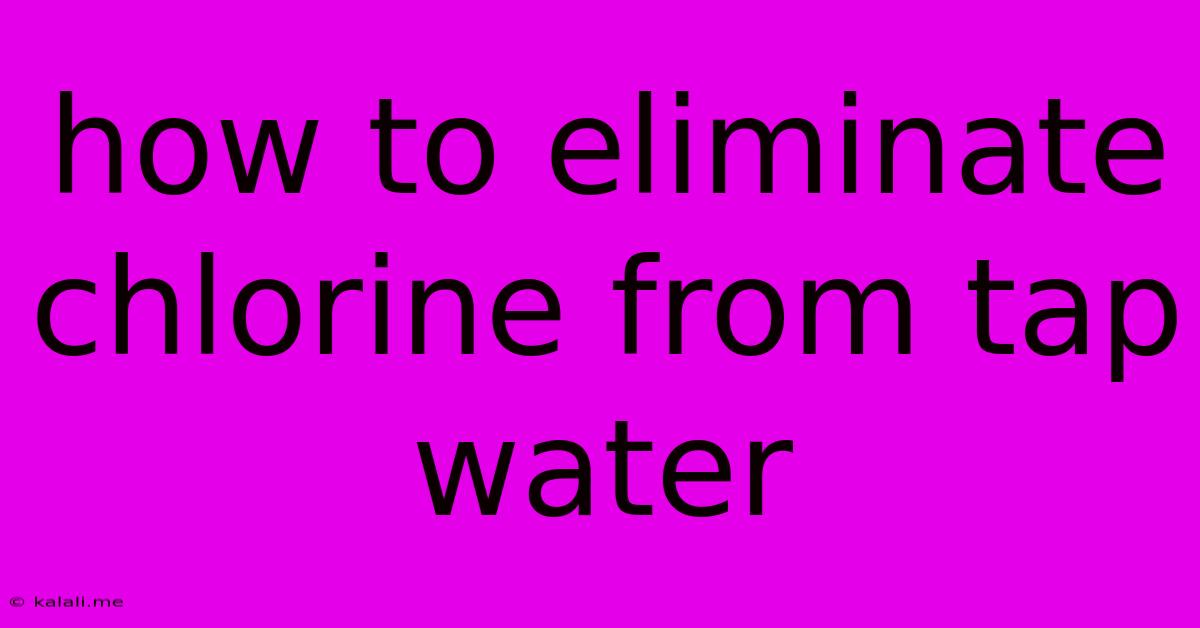How To Eliminate Chlorine From Tap Water
Kalali
Jun 07, 2025 · 3 min read

Table of Contents
How to Eliminate Chlorine from Tap Water: A Comprehensive Guide
Chlorine is a common disinfectant added to municipal tap water to kill harmful bacteria and viruses. While effective for public health, chlorine can impart an unpleasant taste and odor to your drinking water, and some worry about its potential long-term health effects. Fortunately, several methods exist to effectively remove chlorine from your tap water, making it taste better and potentially healthier. This guide explores various options, from simple home solutions to more advanced filtration systems.
Understanding Chlorine in Tap Water
Before diving into removal methods, it's helpful to understand why chlorine is present and what its effects are. Chlorine is added to water during the treatment process to eliminate harmful microorganisms like E. coli and Giardia. While generally safe in the amounts used, high chlorine levels can create a noticeable chemical taste and smell, irritating to some individuals. Furthermore, some people prefer to avoid chlorine due to concerns about potential byproducts formed during disinfection, though the scientific consensus largely affirms the safety of chlorinated water at regulated levels.
Simple and Cost-Effective Methods
Several straightforward techniques can reduce chlorine levels without requiring expensive equipment.
-
Boiling: Boiling water for at least one minute will significantly reduce chlorine levels as it evaporates. However, this method doesn't remove other contaminants, and it's not ideal for large quantities of water.
-
Aerating: Simply letting water sit in an open container for several hours allows chlorine to dissipate into the air. This is a passive method that works best in conjunction with other techniques. You can speed up the process by pouring the water from one container to another repeatedly.
-
Using a Pitcher Filter: Many commercially available pitcher filters contain activated carbon filters which effectively absorb chlorine and other impurities. These are an affordable and convenient solution for households with moderate water consumption. Remember to replace the filter cartridge as recommended by the manufacturer.
More Advanced Filtration Systems
For more thorough chlorine removal and improved water quality overall, consider these options:
-
Faucet-Mounted Filters: These filters attach directly to your kitchen faucet, providing filtered water on demand. Many models utilize activated carbon filters, efficiently removing chlorine, sediment, and other contaminants.
-
Under-Sink Filters: These are more permanent installations that provide a dedicated filtered water line, offering greater flow rates and filter capacity than faucet-mounted filters. They usually also employ activated carbon filtration.
-
Whole-House Filters: This is the most comprehensive approach, filtering all the water entering your home. A whole-house filter offers the ultimate solution for chlorine removal and improved water quality throughout your entire house, impacting your showers and laundry as well. These are usually more expensive to install and maintain.
Choosing the Right Method
The best method for eliminating chlorine from your tap water depends on your budget, water consumption, and desired level of filtration. Consider the following factors:
-
Your budget: Pitcher filters are the most affordable, followed by faucet-mounted filters, under-sink filters, and lastly, whole-house filters.
-
Your water consumption: If you only need filtered water for drinking, a pitcher filter might suffice. For higher consumption, a faucet-mounted or under-sink filter may be necessary.
-
Desired water quality: While all methods reduce chlorine, more advanced systems offer broader contaminant removal, such as sediment, lead, and other chemicals.
By carefully considering these factors and selecting the appropriate method, you can effectively eliminate chlorine from your tap water, enjoying cleaner, better-tasting, and potentially healthier water. Remember to always consult the manufacturer’s instructions for your chosen filtration method to ensure optimal performance and longevity.
Latest Posts
Latest Posts
-
What Does Low Data Mode Mean
Jun 07, 2025
-
The Wedding Supper Of The Lamb
Jun 07, 2025
-
How To Keep Spiders Out Of House
Jun 07, 2025
-
How Does Not Reaching The Equilibrium Impact Dissolution Rate
Jun 07, 2025
-
Difference Between Managed And Unmanaged Switch
Jun 07, 2025
Related Post
Thank you for visiting our website which covers about How To Eliminate Chlorine From Tap Water . We hope the information provided has been useful to you. Feel free to contact us if you have any questions or need further assistance. See you next time and don't miss to bookmark.